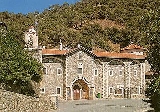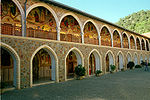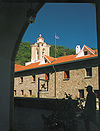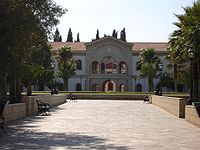
Kykkos Monastery
Encyclopedia
The Holy, Royal and Stavropegic Monastery of Kykkos (Greek:Ιερά Μονή Κύκκου), which lies 20 km west of Pedoulas
, is one of the wealthiest and best-known monasteries
in Cyprus
.
The Holy Monastery of the Virgin of Kykkos was founded around the end of the 11th century by the Byzantine emperor Alexios I Komnenos
(1081 - 1118). The monastery lies at an altitude of 1318 meters on the north west face of Troödos Mountains
. There are no remains of the original monastery as it was burned down many times. The first President of Cyprus, Archbishop
Makarios III
started his ecclesiastical career there as a monk in 1926. He remained fond of the place and returned there many times. His request to be buried there materialised after his death in 1977. His tomb lies 3 km west of Kykkos monastery and remains a popular visitor destination.
 According to tradition, a virtuous hermit called Esaias was living in a cave on the mountain of Kykkos. One day, the Byzantine
According to tradition, a virtuous hermit called Esaias was living in a cave on the mountain of Kykkos. One day, the Byzantine
governor of the island, doux
Manuel Boutoumites
, who was spending the summer at a village of Marathasa because of the heat of the season, went into the forest to hunt. Having lost his way in the forest he met Monk Esaias and asked him to show him the way. The hermit who was not interested in the things of this world would not answer his questions.
Boutoumites got angry at the monk's indifference and called him names and even maltreated him. Not long after, when the doux returned to Nicosia
, he fell ill with an incurable illness by the name of lethargia. In his terrible condition he remembered how inhumanly he had treated the hermit Esaias and asked God to cure him so that he might go to ask the hermit personally for forgiveness. And this came to pass. But God had appeared in front of the hermit and revealed to him that the very thing that had happened had been planned by the divine will and advised him to ask Boutoumites to bring the icon of the Virgin, that had been painted by the Apostle Luke
, to Cyprus.
The icon was kept in the imperial palace at Constantinople. When Boutoumites heard the hermit's wish he was taken aback because he considered such a thing impossible. Then Esaias explained to him that it was a matter of divine wish and they agreed to travel together to Constantinople
for the realization of their aim.
 Time was passing and Boutoumites could not find the right opportunity to present himself in front of the emperor and ask for the icon. For this reason he provided Esaias with other icons and other necessary things and sent him back to Cyprus, at the same time placating him that he would soon see the emperor. By divine dispensation the daughter of the emperor had fallen ill with the same illness that had struck Boutoumites. The latter grasped the opportunity and went to see the Emperor Alexios III Angelos
Time was passing and Boutoumites could not find the right opportunity to present himself in front of the emperor and ask for the icon. For this reason he provided Esaias with other icons and other necessary things and sent him back to Cyprus, at the same time placating him that he would soon see the emperor. By divine dispensation the daughter of the emperor had fallen ill with the same illness that had struck Boutoumites. The latter grasped the opportunity and went to see the Emperor Alexios III Angelos
. He recounted to him his personal experience with the monk Esaias and assured him that his daughter would be cured if he sent to Cyprus the holy icon of the Virgin. In his desperation the emperor, seeing that he had no other option, agreed. His daughter became well instantly. The emperor, however, not wanting to be parted from the icon of the Virgin, called a first-class painter and ordered him to paint an exact copy of the icon with the aim of sending this one to Cyprus.
 In the evening the Mother of God herself appears in a dream of the emperor's and tells him that her wish is for her icon to be sent to Cyprus and for the copy to be kept by the emperor. On the following day the royal boat with the icon of the Virgin departed for Cyprus where Esaias was awaiting for it. During the procession of the icon from the coast to the Troödos Mountains
In the evening the Mother of God herself appears in a dream of the emperor's and tells him that her wish is for her icon to be sent to Cyprus and for the copy to be kept by the emperor. On the following day the royal boat with the icon of the Virgin departed for Cyprus where Esaias was awaiting for it. During the procession of the icon from the coast to the Troödos Mountains
, according to legend, the trees, participating in the welcoming ceremonies, were piously bending their trunks and branches. With patronage provided by the emperor Alexios Komnenos a church and monastery were built at Kykkos, where the icon of the Virgin was deposited.
According to another tradition, still preserved by the people, a bird with human voice was flying around the area singing:
Kykkou, Kykkou, Kykkos' hill
A monastery the site shall fill
A golden girl shall enter in
And never shall come out again
The "golden girl" is, without a doubt, the icon of the Virgin while the monastery is the Holy Royal and Stavropegiac Monastery
of Kykkos which has been sheltering the icon for over nine hundred years.
The icon is never looked at and remains hidden behind a protective covering. It is said that whoever looks at it will be blinded. The last person to have seen the icon is the Pope and Patriarch of Alexandria Gerasimos, in 1669. The icon is rarely uncovered, although this happens on occasion. In recent years there had been a drought affecting Cyprus, in response to which the fathers took the icon to her throne, and read special supplications for rain, whilst looking away from the uncovered icon.
 Kykkos monastery maintains separate grounds Engomi
Kykkos monastery maintains separate grounds Engomi
, Nicosia
called Metochi tou Kykkou (Μετόχι του Κύκκου). The land on which it lies was acquired over the years by the monastery through bequests. With the city's rapid expansion, the area which once used to be in the outskirts has now become prime property. Despite this, much of it is still used for agricultural purposes. Up until the construction of its purpose built premises, the Cyprus State Fair
was held on these grounds.
In 1974, whilst Archbishop Makarios
was under pursuit by the military junta he headed for refuge here. As a result the building was hit by tank fire and part of it collapsed.
Pedoulas
Pedoulas is a village in the Nicosia District of Cyprus, located 4 km south of Moutoullas. The town has a famous St. Michael church....
, is one of the wealthiest and best-known monasteries
Monastery
Monastery denotes the building, or complex of buildings, that houses a room reserved for prayer as well as the domestic quarters and workplace of monastics, whether monks or nuns, and whether living in community or alone .Monasteries may vary greatly in size – a small dwelling accommodating only...
in Cyprus
Cyprus
Cyprus , officially the Republic of Cyprus , is a Eurasian island country, member of the European Union, in the Eastern Mediterranean, east of Greece, south of Turkey, west of Syria and north of Egypt. It is the third largest island in the Mediterranean Sea.The earliest known human activity on the...
.
The Holy Monastery of the Virgin of Kykkos was founded around the end of the 11th century by the Byzantine emperor Alexios I Komnenos
Alexios I Komnenos
Alexios I Komnenos, Latinized as Alexius I Comnenus , was Byzantine emperor from 1081 to 1118, and although he was not the founder of the Komnenian dynasty, it was during his reign that the Komnenos family came to full power. The title 'Nobilissimus' was given to senior army commanders,...
(1081 - 1118). The monastery lies at an altitude of 1318 meters on the north west face of Troödos Mountains
Troodos Mountains
Troodos is the biggest mountain range of Cyprus, located in the center of the island. Troodos' highest peak is Mount Olympus at 1,952 metres.The Troodos mountain range stretches across most of the western side of Cyprus...
. There are no remains of the original monastery as it was burned down many times. The first President of Cyprus, Archbishop
Archbishop
An archbishop is a bishop of higher rank, but not of higher sacramental order above that of the three orders of deacon, priest , and bishop...
Makarios III
Makarios III
Makarios III , born Andreas Christodolou Mouskos , was the archbishop and primate of the autocephalous Cypriot Orthodox Church and the first President of the Republic of Cyprus ....
started his ecclesiastical career there as a monk in 1926. He remained fond of the place and returned there many times. His request to be buried there materialised after his death in 1977. His tomb lies 3 km west of Kykkos monastery and remains a popular visitor destination.
History

Byzantine
Byzantine usually refers to the Roman Empire during the Middle Ages.Byzantine may also refer to:* A citizen of the Byzantine Empire, or native Greek during the Middle Ages...
governor of the island, doux
Dux
Dux is Latin for leader and later for Duke and its variant forms ....
Manuel Boutoumites
Manuel Boutoumites
Manuel Boutoumites or Butumites was a leading Byzantine general and diplomat during the reign of Emperor Alexios I Komnenos , and one of that emperor's most trusted aides...
, who was spending the summer at a village of Marathasa because of the heat of the season, went into the forest to hunt. Having lost his way in the forest he met Monk Esaias and asked him to show him the way. The hermit who was not interested in the things of this world would not answer his questions.
Boutoumites got angry at the monk's indifference and called him names and even maltreated him. Not long after, when the doux returned to Nicosia
Nicosia
Nicosia from , known locally as Lefkosia , is the capital and largest city in Cyprus, as well as its main business center. Nicosia is the only divided capital in the world, with the southern and the northern portions divided by a Green Line...
, he fell ill with an incurable illness by the name of lethargia. In his terrible condition he remembered how inhumanly he had treated the hermit Esaias and asked God to cure him so that he might go to ask the hermit personally for forgiveness. And this came to pass. But God had appeared in front of the hermit and revealed to him that the very thing that had happened had been planned by the divine will and advised him to ask Boutoumites to bring the icon of the Virgin, that had been painted by the Apostle Luke
Luke the Evangelist
Luke the Evangelist was an Early Christian writer whom Church Fathers such as Jerome and Eusebius said was the author of the Gospel of Luke and the Acts of the Apostles...
, to Cyprus.
The icon was kept in the imperial palace at Constantinople. When Boutoumites heard the hermit's wish he was taken aback because he considered such a thing impossible. Then Esaias explained to him that it was a matter of divine wish and they agreed to travel together to Constantinople
Constantinople
Constantinople was the capital of the Roman, Eastern Roman, Byzantine, Latin, and Ottoman Empires. Throughout most of the Middle Ages, Constantinople was Europe's largest and wealthiest city.-Names:...
for the realization of their aim.

Alexios III Angelos
Alexios III Angelos was Byzantine Emperor from 1195 to 1203.- Early life:Alexios III Angelos was the second son of Andronikos Angelos and Euphrosyne Kastamonitissa. Andronicus was himself a son of Theodora Komnene, the youngest daughter of Emperor Alexios I Komnenos and Irene Doukaina. Thus...
. He recounted to him his personal experience with the monk Esaias and assured him that his daughter would be cured if he sent to Cyprus the holy icon of the Virgin. In his desperation the emperor, seeing that he had no other option, agreed. His daughter became well instantly. The emperor, however, not wanting to be parted from the icon of the Virgin, called a first-class painter and ordered him to paint an exact copy of the icon with the aim of sending this one to Cyprus.

Troodos Mountains
Troodos is the biggest mountain range of Cyprus, located in the center of the island. Troodos' highest peak is Mount Olympus at 1,952 metres.The Troodos mountain range stretches across most of the western side of Cyprus...
, according to legend, the trees, participating in the welcoming ceremonies, were piously bending their trunks and branches. With patronage provided by the emperor Alexios Komnenos a church and monastery were built at Kykkos, where the icon of the Virgin was deposited.
According to another tradition, still preserved by the people, a bird with human voice was flying around the area singing:
Kykkou, Kykkou, Kykkos' hill
A monastery the site shall fill
A golden girl shall enter in
And never shall come out again
The "golden girl" is, without a doubt, the icon of the Virgin while the monastery is the Holy Royal and Stavropegiac Monastery
Monastery
Monastery denotes the building, or complex of buildings, that houses a room reserved for prayer as well as the domestic quarters and workplace of monastics, whether monks or nuns, and whether living in community or alone .Monasteries may vary greatly in size – a small dwelling accommodating only...
of Kykkos which has been sheltering the icon for over nine hundred years.
The icon of Virgin Mary
Throughout the centuries locals have revered the icon and have attributed miracles to its presence. In 1760 a success in the struggle against locust devastation, a frequent problem of the time was believed to be the work of the icon. The icon has also served as a template for other paintings depicting the Madonna in eastern Orthodoxy.The icon is never looked at and remains hidden behind a protective covering. It is said that whoever looks at it will be blinded. The last person to have seen the icon is the Pope and Patriarch of Alexandria Gerasimos, in 1669. The icon is rarely uncovered, although this happens on occasion. In recent years there had been a drought affecting Cyprus, in response to which the fathers took the icon to her throne, and read special supplications for rain, whilst looking away from the uncovered icon.
Other relics
There are placed to the right of the icon a bronze arm, and a sword fish saw. Regarding the arm, this serves as a reminder the story of a Turk who tried to light a cigarette using one of the vigil lamps and he was cursed and suffered a gangrenous arm. The saw from the sword fish represents the gratefulness of sailors who prayed to Our Lady of Kykkos to save them from the storms of the sea.Metochion Kykkou

Engomi
This article is about the suburb of Nicosia. For the ancient settlement near Famagusta, see: EnkomiEngomi is a suburb of the Cypriot capital Nicosia. It has a population of around 13,600 . It is a mainly residential neighbourhood with many large villas...
, Nicosia
Nicosia
Nicosia from , known locally as Lefkosia , is the capital and largest city in Cyprus, as well as its main business center. Nicosia is the only divided capital in the world, with the southern and the northern portions divided by a Green Line...
called Metochi tou Kykkou (Μετόχι του Κύκκου). The land on which it lies was acquired over the years by the monastery through bequests. With the city's rapid expansion, the area which once used to be in the outskirts has now become prime property. Despite this, much of it is still used for agricultural purposes. Up until the construction of its purpose built premises, the Cyprus State Fair
Cyprus State Fairs Authority
The Cyprus State Fairs Authority was established in 1968 as a semi-government organization in order to run and promote the annual Cyprus International Fair. It has since expanded and runs several annual and biannual events such as the education fair, and the Cyprus motor show.The largest event the...
was held on these grounds.
In 1974, whilst Archbishop Makarios
Makarios III
Makarios III , born Andreas Christodolou Mouskos , was the archbishop and primate of the autocephalous Cypriot Orthodox Church and the first President of the Republic of Cyprus ....
was under pursuit by the military junta he headed for refuge here. As a result the building was hit by tank fire and part of it collapsed.

